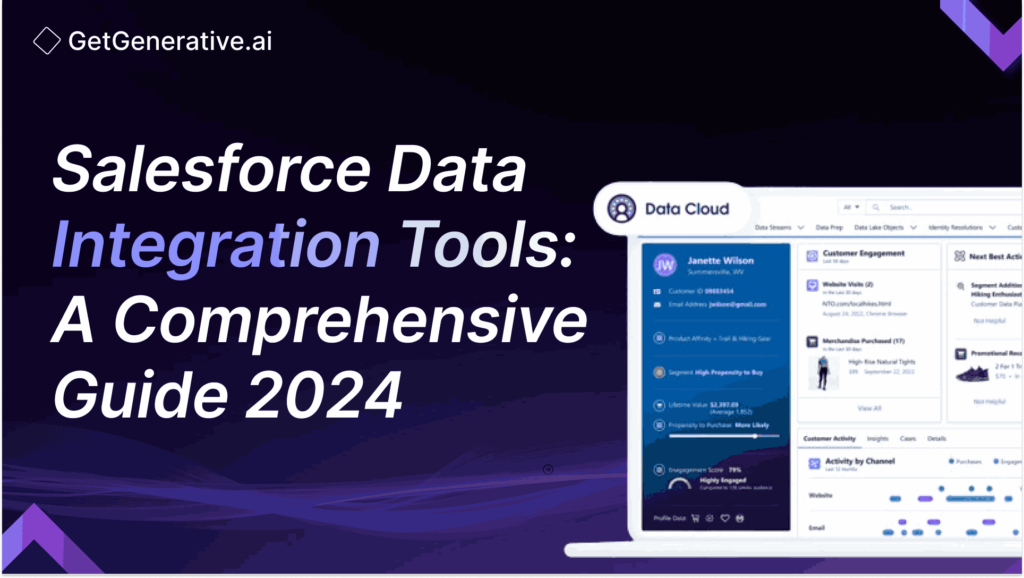Salesforce Data Integration Tools: A Comprehensive Guide 2024
In today’s data-driven business landscape, seamlessly integrating and managing data across various platforms is crucial for success. As a leading customer relationship management (CRM) platform, Salesforce plays a pivotal role in this ecosystem.
According to recent statistics, 83% of Fortune 500 companies use Salesforce, and the platform manages over 10 billion customer data records daily. With such vast amounts of data, efficient integration tools have become indispensable.
What are Salesforce data integration tools?
Salesforce data integration tools are software solutions designed to connect Salesforce with other applications and databases, enabling the smooth flow of information between systems. These tools help businesses consolidate data from various sources, ensuring consistency and accuracy across all platforms.
How do Salesforce data integration tools work?
Salesforce data integration tools typically use APIs (Application Programming Interfaces) and connectors. They extract data from source systems, transform it to match Salesforce’s data model and load it into the platform. This process, known as ETL (Extract, Transform, Load), can be scheduled to run automatically at regular intervals or triggered by specific events.
Examples of Salesforce data integration tools
MuleSoft Anypoint Platform
- Acquired by Salesforce in 2018
- Offers a unified platform for API-led connectivity
- Provides both cloud-based and on-premises integration solutions
- Features include visual design tools, pre-built connectors, and robust security measures
Informatica Cloud Data Integration
- Known for its user-friendly interface and drag-and-drop functionality
- Offers real-time and batch integration capabilities
- Includes advanced data quality and master data management features
- Provides AI-powered automation for data mapping and transformation
Jitterbit Harmony
- Specializes in rapid integration deployment with pre-built templates
- Offers both cloud and on-premises solutions
- Includes a low-code integration platform for citizen integrators
- Provides robust API management capabilities
Dell Boomi AtomSphere
- Cloud-native integration platform as a service (iPaaS)
- Features a large library of pre-built connectors
- Offers data quality and master data management tools
- Includes AI-assisted data mapping and integration recommendations
Talend Data Integration
- Open-source roots with both open-source and commercial versions
- Provides a comprehensive suite of data integration and data quality tools
- Offers strong support for big data and cloud integration scenarios
- Includes features for data governance and compliance
Workato
- Known for its user-friendly, recipe-based integration approach
- Offers AI-powered automation and integration capabilities
- Provides a large library of pre-built connectors and integrations
- Features strong support for enterprise-grade security and governance
Also Read – Salesforce Data Migration Tools: A Comprehensive Guide
Celigo integrator.io
- Specializes in NetSuite and Salesforce integrations
- Offers pre-built integration apps for common business processes
- Provides a low-code integration platform for custom integrations
- Includes features for error handling and monitoring
SnapLogic Intelligent Integration Platform
- Utilizes AI and machine learning for faster integrations
- Offers a library of pre-built connectors called Snaps
- Provides both cloud and on-premises deployment options
- Features a self-service integration interface for business users
Each tool offers unique features and capabilities, catering to different integration needs and complexity levels. When selecting a Salesforce data integration tool, consider factors such as ease of use, scalability, security features, and compatibility with your existing technology stack.
Benefits of using Salesforce for data integration
- 360-degree customer view: Integrating data from multiple sources provides a comprehensive understanding of customer interactions and preferences.
- Improved decision-making: Access to real-time, accurate data across systems enables better-informed business decisions.
- Increased productivity: Automated data synchronization reduces manual data entry and minimizes errors.
- Enhanced customer experience: Integrated data allows for more personalized and timely customer interactions.
- Scalability: Salesforce’s robust infrastructure can handle large volumes of data as your business grows.
Challenges with Salesforce data integration
- Data quality issues: Inconsistent or duplicate data can lead to integration problems.
- Security concerns: Ensuring data protection across multiple systems can be complex.
- Technical complexity: Integration projects often require specialized skills and resources.
- Maintaining data relationships: Preserving complex data relationships across systems can be challenging.
- Managing real-time vs. batch integration: Balancing the need for real-time updates with system performance.
Salesforce data integration best practices
- Clearly define integration objectives and requirements.
- Implement a data governance strategy to maintain data quality.
- Use a phased approach for complex integration projects.
- Regularly monitor and audit integration processes.
- Provide adequate training for users and administrators.
- Choose integration tools that align with your specific business needs and technical capabilities.
Also Read – Salesforce Automation Tools: A Comprehensive Guide
How to implement Salesforce data integration?
- Assessment: Evaluate your current systems and data requirements.
- Planning: Define integration objectives, scope, and timeline.
- Tool selection: Choose appropriate integration tools based on your needs.
- Data mapping: Create a detailed map of how data will flow between systems.
- Development and testing: Build and thoroughly test integration processes.
- Deployment: Roll out the integration solution in phases.
- Monitoring and optimization: Continuously monitor performance and make necessary adjustments.
How does Salesforce integrate with major data systems like SAP and Oracle?
Salesforce offers pre-built connectors for major enterprise systems like SAP and Oracle. These connectors leverage APIs to facilitate bidirectional data flow. For SAP, Salesforce provides the SAP Connector, which supports real-time and batch integration scenarios. For Oracle, the Oracle Eloqua AppCloud connector enables seamless integration between Salesforce and the Oracle Eloqua marketing automation platform.
Related Read – Top Salesforce Tools – You Should Know
Conclusion
Salesforce data integration tools are essential for businesses looking to leverage the full potential of their data across multiple systems. By implementing robust integration solutions and following best practices, organizations can achieve a unified view of their data, improve operational efficiency, and deliver superior customer experiences.
Enhance your Salesforce consulting with GetGenerative.ai. Effortlessly craft outstanding proposals, enabling you to dedicate more time to providing exceptional client service.
Start today!
Frequently Asked Questions (FAQs)
1. How often should I sync data between Salesforce and other systems?
The frequency depends on your business needs. Real-time synchronization is ideal for critical data, while daily or weekly syncs may suffice for less time-sensitive information.
2. Can Salesforce integrate with custom or legacy systems?
Yes, Salesforce can integrate with custom and legacy systems using APIs and custom connectors developed by integration partners or in-house teams.
3. Is it necessary to use a third-party integration tool, or can I use Salesforce’s native capabilities?
While Salesforce offers some native integration features, third-party tools often provide more advanced capabilities and support for complex integration scenarios.
4. How does data integration impact Salesforce performance?
Properly implemented integrations should have minimal impact on performance. However, large data volumes or frequent real-time syncs may require optimization to maintain system responsiveness.
5. What security measures should I consider when integrating Salesforce with other systems?
Implement encryption for data in transit and at rest, use secure authentication methods, regularly audit access controls, and ensure compliance with relevant data protection regulations.




